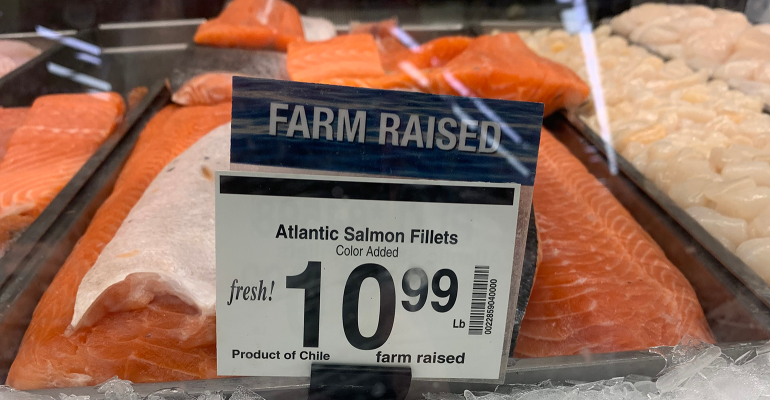Educating shoppers on the origins of the various seafood species is becoming a more vital, and frequently arduous, endeavor.
The terms “farm-raised” and “aquaculture” are a major riddle to many shoppers, and confusion about the meanings is keeping many potential buyers on the sidelines, analysts said.
Research from Arlington, Va.-based FMI — The Food Industry Association found that just 23% of seafood shoppers prefer farm-raised selections, while 39% favor wild-caught, and 39% have no preference or do not know the difference between farm-raised and wild-caught.

Most shoppers understand the origins of wild-caught seafood.
Likely contributing to the greater preference for wild-caught is the substantial number of seafood shoppers (63%) who indicate that they totally understand what wild-caught means, FMI notes in its The Power of Seafood 2024 report.
In contrast, 57% of seafood consumers are less knowledgeable about farm-raised, with many also unclear about specific types, including indoor farm-raised, The Power of Seafood states.
Aquaculture, which involves the breeding, rearing, and harvesting of fish, shellfish, algae, and other organisms in all types of water environments, is producing such species as oysters, clams, mussels, shrimp, seaweeds, salmon, black sea bass, sablefish, yellowtail, and pompano.
Seafood consumers who favor farm-raised cite such attributes as being better for the environment (43%), being sustainable (43%), knowing how it was raised (43%), being healthier/more nutritious (40%), knowing where it is from/traceable (37%), having impact on the availability of seafood (34%), having less exposure to pollutants (33%), and having higher Omega-3s (31%), FMI reports.
Those who prefer wild-caught believe it is better quality (54%), more natural (46%), free of antibiotics (41%), fresher (39%), and has no additives (39%).
“While farm-raised seafood may be the preference of only about one-quarter of seafood consumers, [one should not] infer they disapprove of seafood raised via aquaculture,” The Power of Seafood states, noting that just 17% of seafood consumers disapprove of farm-raised seafood, while 58% approve.
It is important that retailers maintain a strong mix of wild-caught and farm-raised selections to attract shoppers who prefer one or the other and to help maintain a vibrant eco-system, said Rick Stein, FMI vice president of fresh foods.
“We need a balance of aquaculture and wild-caught in order to have a sustainable seafood system,” he said. “If we were to eliminate farm-raised we would ravage the oceans and have all kinds of sustainability issues. Being dependent on one versus the other can end up wiping out fisheries.”
Educating shoppers on farm-raised, however, can be tricky, Stein said. “Telling consumers that fisheries will be more sustainable from buying aquaculture may lead them to infer that purchasing wild-caught may lead to the elimination of fisheries, and that is not the case,” he said. “Retailers need to promote balance and that is very tough.”
It also is difficult to explain the meaning of aquaculture, Stein said. “It is technical conveying how there is a creation of pens in the ocean off the coast and that the seafood is fed and harvested. It is not an easy story to tell.”
Nevertheless, merchandisers should focus on educating consumers by having knowledgeable seafood department associates who can answer questions and provide insights on both farm-raised and wild-caught, he said, while also including such information on the retailers’ digital platforms.
“That needs to be done in a way that just presents data and does not advocate one over the other,” he said. “Seafood is a complicated category and it is a struggle for retailers and suppliers to get all the product nuances out there.”
The proportion of wild-caught and farm-raised selections in stores will likely vary in accordance with the demand for specific species in each location.
About 70% of highly popular salmon, for instance, are farmed raised, reports Statista Inc., a New York-based global data and business intelligence platform. In 2023, approximately 90.6 million metric tons of fish were captured, while 96 million metric tons were raised in aquaculture, Statista states.
Interest in aquaculture also is gradually increasing. Shopper preference for farm-raised seafood rose from 20% in 2022 to 23% last year, The Power of Seafood reports. Preference for wild-caught fell to 39% from 45%. Those indicating no preference rose to 39% from 36%.
In addition, there are greater amounts of farm-raised seafood in stores, Stein said, noting that “it used to be that only wild-caught was available, but farm-raised has become a solution to production efficiency and sustainability by preventing over-fishing in the wild waters.”
“We have to continue to try to make inroads in alerting the American consumer that having a combination of wild-caught and aquaculture creates a sustainable fishery for the ages,” he said.




